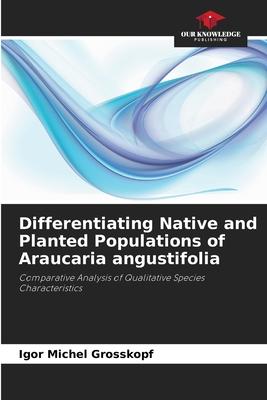The Araucaria pine has been exploited since colonial Brazil, as have many natural resources. This vast exploitation has grown throughout our country’s history, and environmental legislation has had to evolve to prevent species from becoming extinct. These changes have brought us to the current position, where the Araucaria angustifolia species is prohibited from exploitation, with rare exceptions such as in the case of proof of planting. However, this proof is not simple. According to the legislation, one of the ways of proving a planted Araucaria population is by presenting the implementation documents. However, in most cases there is no such documentation. It is therefore up to the technician responsible for exploiting the forest resource to prove that it is not a native population. The aim of this study was to analyze techniques that prove the origin of an Araucaria population by comparing qualitative characteristics, serving as a subsidy for professionals and inspectors when it comes to environmental licensing. Variables such as "Alignment", "Tree Size Pattern", "Canopy Structure and Formation", among others, were analyzed for this comparison.
| FindBook |
有 1 項符合
Differentiating Native and Planted Populations of Araucaria angustifolia的圖書 |
 |
Differentiating Native and Planted Populations of Araucaria angustifolia 作者:Grosskopf 出版社:Our Knowledge Publishing 出版日期:2024-03-30 語言:英文 規格:平裝 / 56頁 / 22.86 x 15.24 x 0.33 cm / 普通級/ 初版 |
| 圖書館借閱 |
| 國家圖書館 | 全國圖書書目資訊網 | 國立公共資訊圖書館 | 電子書服務平台 | MetaCat 跨館整合查詢 |
| 臺北市立圖書館 | 新北市立圖書館 | 基隆市公共圖書館 | 桃園市立圖書館 | 新竹縣公共圖書館 |
| 苗栗縣立圖書館 | 臺中市立圖書館 | 彰化縣公共圖書館 | 南投縣文化局 | 雲林縣公共圖書館 |
| 嘉義縣圖書館 | 臺南市立圖書館 | 高雄市立圖書館 | 屏東縣公共圖書館 | 宜蘭縣公共圖書館 |
| 花蓮縣文化局 | 臺東縣文化處 |
|
|
圖書介紹 - 資料來源:博客來 評分:
圖書名稱:Differentiating Native and Planted Populations of Araucaria angustifolia
Old-Growth Forest Walks: 26 Hikes in Ontario’s Greenbelt
Go Forth and Forage: A Guide to Foraging Over 50 of the Most Common Edible & Medicinal North American Mushrooms
Top Trees: Playing Cards
75 Plants with Superpowers
Letter to a Dandelion: Earth Verse for Gardeners & Nature Lovers
Letter to a Dandelion: Earth Verse for Gardeners & Nature Lovers
In Vitro Production of Plant Secondary Metabolites: Theory and Practice
Plant Galls: Structure and Functions
Pacific Northwest Foraging for Beginners: Embracing Nature’s Flavors in the Pristine Wilderness - An Essential Field Guide to Wild Edibles
Physiology of Halophytes: Signaling, Omics, and Tolerance Mechanisms
Go Forth and Forage: A Guide to Foraging Over 50 of the Most Common Edible & Medicinal North American Mushrooms
Top Trees: Playing Cards
75 Plants with Superpowers
Letter to a Dandelion: Earth Verse for Gardeners & Nature Lovers
Letter to a Dandelion: Earth Verse for Gardeners & Nature Lovers
In Vitro Production of Plant Secondary Metabolites: Theory and Practice
Plant Galls: Structure and Functions
Pacific Northwest Foraging for Beginners: Embracing Nature’s Flavors in the Pristine Wilderness - An Essential Field Guide to Wild Edibles
Physiology of Halophytes: Signaling, Omics, and Tolerance Mechanisms
|










